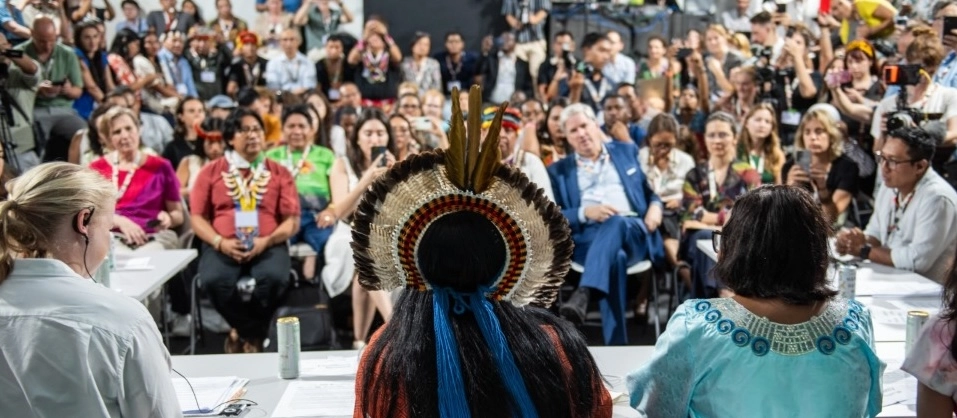Sustainability storytelling: Driving climate advocacy

Why facts alone won’t drive climate action
In the fight for climate action, facts and figures alone aren’t enough. Despite an overwhelming body of scientific evidence, progress often stalls, not because people don’t understand the data, but because it fails to connect on an emotional level.
For opinion leaders, organisations and policymakers, the challenge isn’t just to inform – it’s to inspire. And that’s where digital storytelling comes in.
Stories shape how people perceive problems and solutions. They make issues personal, drive engagement and, when done right, they have the power to influence decision-making at the highest levels.
So, how can organisations, businesses and brands harness the power of sustainability storytelling to drive real change and add value?
Why storytelling is a business imperative for sustainability leaders
For business leaders, sustainability is no longer just a corporate responsibility issue – it’s a strategic business imperative. Citizens, investors and employees are increasingly making purchasing, career and investment decisions based on a company’s environmental commitments, as recent studies by McKinsey, Morgan Stanley and PwC show. The organisations that communicate their impact with clarity and conviction are the ones building trust, driving loyalty and securing long-term competitive advantage.
How storytelling drives business value
Builds investor confidence and market differentiation
For companies seeking investment, a clear sustainability narrative is now a key driver of valuation. Investors want more than ESG reports and net zero claims, they want to see credible commitments that are backed by evidence and communicated with clarity.
According to the latest Science Based Targets initiative (SBTi) report, the number of companies with validated science-based targets more than doubled in 2023, rising by 102% compared to the year before. This surge reflects a growing expectation from investors for businesses to demonstrate how climate action is embedded into long-term strategy, not just corporate reporting.
Attracts and helps to retain talent
Employees – especially younger generations – are actively seeking out employers whose values align with their own. For Gen Z and Millennials, climate action and corporate purpose aren’t perks, they are prerequisites.
A 2024 Deloitte Global Gen Z and Millennial Survey found that over 75% of young workers say a company’s environmental impact influences their decision to join or stay with an employer. What’s more, nearly 40% have rejected job offers or left roles that didn’t align with their values.
Organisations that have a strong environmental mission can use communications to authentically share their climate commitments and attract top talent. This helps build more engaged, motivated teams and stronger workplace culture, as when your workforce believes in your mission, they become your most powerful ambassadors.
“When we feel our work matters it has a transformational impact on the way we do our jobs.” Bruce Daisley, bestselling author of Eat Sleep Work Repeat and The Joy of Work
It’s clear that employees – particularly younger generations – want to work for companies and organisations that align with their values. Brands that use sustainable marketing to authentically communicate their climate commitments attract top talent and build stronger workplace cultures.
The takeaway: Sustainability storytelling isn’t just about advocacy. It’s about driving business growth, citizen loyalty and investment confidence.
Helps citizens use their soft power more effectively
The ‘conscious citizen’ isn’t just making noise, they’re using their soft (spending) power to shape the market. A 2024 study by NielsenIQ found that products with strong sustainability credentials grew sales at twice the rate of conventional alternatives. Purpose has become a competitive advantage but only for brands that can clearly communicate it. In a crowded marketplace, those who fail to articulate their values, build trust and show impact risk being left behind. The brands that stand out are the ones who turn purpose into a compelling narrative – one that not only reflects their values, but inspires a vision for the future.
Three storytelling techniques that cut through
To create compelling narratives that drive action, organisations need to go beyond traditional sustainable communications and marketing tactics and focus on three key techniques:
1. Lead with people, not just data
People connect with people, not statistics. The most impactful climate communicators don’t just talk about CO₂ levels and global temperature rises, they tell stories about real communities experiencing the effects of climate change.
Case study: Business for Nature – Giving nature a voice
Greenhouse worked with Business for Nature to shift sustainability narratives away from abstract targets and towards tangible, human-led stories. By showcasing real-world examples of businesses embedding nature into their decision-making, we helped build unstoppable momentum behind a new global norm: mandatory nature-related disclosure.
The communications campaign supported Business for Nature in mobilising over 1,400 businesses across more than 70 countries to call on governments to make nature impact disclosure mandatory. This unified business voice played a pivotal role in influencing discussions at COP15 and was instrumental in securing a commitment to make nature disclosure mandatory within the Global Biodiversity Framework – a landmark moment in global environmental governance.
Takeaway: Whether you’re a leading organisation seeking to shift buyer behaviour or a policymaker wanting to raise awareness, your messaging and narrative should centre around human impact to create lasting engagement.
2. Make the audience the hero
The best storytelling doesn’t just tell people what to think, it invites them to see themselves as part of the solution.
Case study: NatPower – powering change at a human level
When it comes to energy transition, big visions are vital – but they only become reality when they’re grounded in people, places and partnerships.
That’s the approach Greenhouse took with NatPower UK, a company on a mission to build the UK’s first nationwide grid-scale battery storage network.
Rather than talking in tech jargon or megawatts, the campaign zoomed in on the real people who could make this vision possible: the landowners and farmers. By positioning them as enablers of the UK’s clean energy future and connecting the project to shared values like stewardship and community legacy, the work reframed a national ambition in personal, empowering terms.
The campaign generated widespread public and media engagement, reaching over 675 million people, securing more than 100 media placements, and resulting in more than 50 high-quality partnership enquiries. This demonstrated powerfully how human storytelling can unlock real-world participation in the energy transition.
Takeaway: Don’t just speak to your audience – co-create with them. When you take the time to listen to people’s hopes, fears and motivations, you uncover the insight that turns messaging into meaning. That’s how you build authentic narratives that not only resonate, but mobilise. Because the most powerful stories are the ones where your audience sees themselves as the hero.
3. Show the change, not just the problem
Fear-driven narratives can be overwhelming. Instead of just highlighting climate risks, the most effective sustainability communications campaigns showcase real solutions in action.
Greenhouse partnered with One Acre Fund to show what climate resilience really looks like on the ground. Instead of focusing solely on the vulnerabilities facing smallholder farmers in Africa, the campaign highlighted the solutions already working – from regenerative practices to access to climate finance.
Through strategic messaging and media outreach around COP, we elevated smallholder farmers as frontline climate leaders. The campaign achieved cut-through in a competitive news cycle, positioning One Acre Fund as a go-to voice on sustainable agriculture and unlocking fresh support for grassroots solutions.
Takeaway: Shift the lens from risk to resilience. Audiences don’t just need to know what’s going wrong – they need to see what’s working. By spotlighting the people already driving change, you replace doom with direction, and fear with agency. That’s how you inspire action and build momentum for a more resilient future.
What doesn’t work in climate storytelling?
While powerful sustainability storytelling can drive real change, getting it wrong can damage credibility. Here’s what to avoid:
- Greenwashing: Organisations in the environmental space must ensure that their messaging is backed up by genuine evidence and action. Overhyping commitments without real proof erodes trust.
- Over-reliance on data: Decision-makers may need numbers, but the broader audience needs compelling narratives to stay engaged.
- Doom and gloom narratives: Fear-driven storytelling without clear solutions can make people disengage rather than act.
The Greenhouse approach: Driving real impact through authentic storytelling
At Greenhouse, we’ve spent decades working with innovation founders, business leaders, global NGOs and policymakers to shape impactful narratives that can work across all channels.
The organisations we work with are incredibly diverse. Each has their own unique message to share. Each one is highly specialist, nuanced and rooted in distinct contexts. Alongside this, the audiences we seek to engage are global and equally varied.
Yet across all our work, one thing holds firm: powerful climate action depends on more than facts. Stories must do more than inform. Communications must inspire and mobilise – and we do this best when we place humans at the centre.
Want to elevate your climate storytelling and avoid common pitfalls? Get in touch to discover how we can help you craft a compelling sustainability marketing strategy that drives real-world change.



